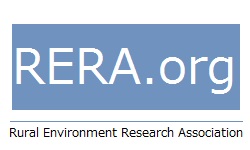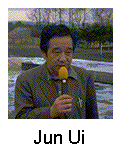|

English
/ Japanese / Chinese
Welcome
Hybrid
Lagoon System (“HLS”)
HLS's
Carrier and Reference
Our
Organization
Contact
|
Dr.
Jun Ui

PERSONAL
DATA
Birth
date: June 25, 1932
Marital Status: Married, three
children
Nationality: Japanese
EDUCATION
1956.
Bachelor of Engineering in Chemical Engineering Course of
Department of Applied Chemistry in Faculty of Engineering
University of Tokyo.
1962.
Master of Engineering in Master Course of Graduate School in
Department of Applied Chemistry, University of Tokyo.
PRESENT
STATUS AND POSITION
Professor
of Environmental Science, also teaching: basic principles of
environmental pollution, since l986. Dean of Okinawa University
Library, since 1987-89 Director, Research Institute on Regional
Studies, 1988
PREVIOUS
EXPERIENCE
1956-59:
Worked in Japanes Geon Company as a chemical engineer in the
construction of polyvinyl, chloride plant in Takaoka City: its
operation and maintenance; later in the sales department as a
sales engineer for plastic processing in Tokyo and Osaka office.
1959-:
The research on Minamata Disease, heavy organic mercury
poisoning, caused by industrial waste pollution, disclosure of
the results, support of victims movement, court cases for the
determination of legal responsibility. The case studies on
mercury pollution in U. S. Canada, Sweden, Finland, Italy,
Brasil, etc.
1962-:
The survey of river water quality in Tochigi Prefecture region
and its monitoring by periodical sampling and analysis.
1965-:
The study on the role of citizens' movement in the environmental
issues in Japan, its promotion as a concerned scientist.
1965-86:
Worked as a research assistant, teaching technical exercises in
Department of Urban Engineering, Faculty of Engineering,
University of Tokyo.
1969-:
The study on sewage treatment as a kind of appropriate
technology, design of simple oxidation ponds built by local
people.
1970-85:
Operation of Jishu-Koza (independent free lecture movement for
citizens self-education) in University of Tokyo, on the
principles of pollution.
1974-85:
The Study on multi -disciplinary reform plan of higher education,
especially on the relationship of university to the changing
society of Japan.
1982-83:
Visiting Professor in Department of Fisheries and Wildlife,
Michigan State University, East Lansing Michigan, in Fulbright
program.
COURSES
TAUGHT
Lecture
in: undergraduate course: Okinawa's environment, principles of
pollution, water chemistry, sewage treatment. Lecture in graduate
course: principles of pollution Exercise in undergraduate course:
water chemistry, water analysis, field survey of natural surface
water, regional planning of water pollution control. Lecture of
Jishu-Koza : reporter and coordinator of lecture series for
principle of pollution.
CONSULTING
WORK
Study
on flow property of polymer melt, Association of Polyvinyl
Chloride Manufacturers, 1960-62.
Scientific
advisor and expert committee member in The Water Quality Control
Board of Tochigi Prefecture, 1965-86
Scientific
advisor to the lawyers team in the civil court case of second
Minamata Disease (Niigata District Court), 1967-71.
Scientific
advisor to the lawyers team in the criminal court case of Kochi
Pulp, citizebs' non-violent sealing of waste discharge(Kochi
District Court), 197l-75
Design
and maintenance know-how of simple treatment plant for sewage
and industrial wastewater, Tochigi Fuji Sangyo Company, 1975.
Planning,
design, and maintenance know-how of simple, systematic treatment
plant for sewage and industrial waste water, Isone Design
Office, 1976-.
PROFESSIONAL
SOCIETIES AND INSTITUTIONS:
Japan
Association of Civil Engineers
Chemical
Society of Japan
Science
Council of Japan
Member,
Research Planning Council of PACFM IN MARIBUS (an international
consult-ing body for peaceful use of ocean, led by Mrs.
Elisabeth Mann Borgese, office in International Ocean Institute,
P.O. Box 524, Valletta, Malta); since l972
Expert
Member, GESAMP (Group of Experts on Scientific Aspects on Marine
Pollut-ion), organized by UN and other international agencies in
1971, 72
President,
Asian Environmental Society, a status NGO in UNEP, since 1979.
Board
Member, Environmental Liaison Centre, a coalition of national,
regional, and international NGOs in environmental field,
1981-86.
GRANTS,
AWARDS, AND SCHOLARSHIPS
World
Health Organization: Senior Research Training Grant, 1968-69;
one year field research in Europe on mercury and other
industrial wastes pollution.
Finland
Nature Conservation Association: Special Grand Prize on the
warning of danger of environmental pollution by mercury, 1970.
Mainichi
Publication Prize: Principles of Pollution, published by Keis
Shob,1972
Chunichi
Shimbun Grant for Expedition on World Pollution, 1975.
Fulbright
Scholarship: Exchange Scholar on citizens participation in the
environmental issues in U. S., 1982-83.
SMON
Prize, 1990
UNEP
GLOBAL 500,1991
FIELD
OF INTEREST
Case
studies of pollution, Principles of pollution, history of
Japanese pollution, and its analytical study. New international
phenomena such as pollution export and related unappropriate
technology transfer.
Role
of movement by people as a preventive power of pollution.
Small
scale sewage and other organic waste treatment by oxidation
pond, and application of wind energy to save mechanical energy
for the treatment.
Simplified
chemical, water analysis, applied by secondary school pupils.
Simplified
survey for water pollution level and identification of polluting
sources, popularization of control methods.
Organization
of adult and voluntary education in the university system
Jishu-Koza
(independent forum) movements as an effort of university
reformation, and its application to the survival plan of Okinawa
University under heavy competitive condition in Japanese higher
education system.
Critical
review, of regional development plans in Okinawa area,
especially on new Ishigaki Airport plan in Shiraho village.
PUBLICATIONS
Jun
Ui, Kogai no Seijigaku (Politics of Pollution), Sanseido, Tokyo,
1968. (J)
Jun
Ui, UI report (A Report on Europian Pollution), Aki Publishers,
Tokyo, 1970. (J)
Jun
Ui, Kogai Genron (Principles of Pollution), I, II, III, Aki
Publishers, Tokyo, 1972 (J)
Jun
Ui, Kogai Genron, second series, I, II, III, IV, Keis
Publishers, Tokyo, 1972 (J)
Jun
Ui, Watashi no Kogai Ts (My Battle Against Pollution), Ushio
Books, Tokyo, 1972 (J)
S,
Nakayama and E, Yagi (Editors), Science and Society in Modern
Japan Tokyo University Press, Tokyo, 1973, (E)
Jun
Ui, Kogai Genron, supplements, I, II, III, Aki Publishers, Tokyo
, 1974. (J)
Jun
Ui, Kogai retto nanajuu nendai (Polluted Archiperago in
Seventies), Aki Publishers, Tokyo, 1974,(J)
Jun
Ui(Editor),Daigaku kaitai ron (Disbanding University System), I,
II, III, Aki Publishers, Tokyo, 1975(J)
Jun
Ui, Jumin o musubu tabi (Travel to Connect people), Chikuma
Publishers, Tokyo, 1977 (J)
S.
Tsuru (Editor), Sekai no kogai chizu (World Map in Pollution),
Iwanami Books, Tokyo, 1978. (J)
Jun
Ui, Kimiyo aruite kangaero (Walk and Think Young You!), Popula
Book, Tokyo, 1979. (J)
Jun
Ui, Furusato no mizu (Water in Our Homeland). Aki Publishers,
Tokyo, 1983. (J)
Jun
Ui (Editor), Gijutsu to sangyo kogai (Technology and Industrial
Pollution), Tokyo university Press, Tokyo. 1985. (J)
Jun
Ui (Editor). Mirai sangyo no kozo (Structure of Future
Industry), Aki Publishers, Tokyo, 1986. (J)
Jun
Ui (Editor), United Nation University, Project Series Number
Five, "The Japan Experience" Technological Transition
and Industrial Pollution, to be published in near future.
Chapter 1 Overview, Chapter 4 Minamata Disease, and Conclusion.
(E)
S.
Tsuru and H. Weidner. Books title undetermined
Wissenshaftzentrum, Berlin published in 1987, 88. Three
chapters, titled as follows: An analysis of recent Japanese
anti-pollution movements and other related "jumin undo"
type grassroot organizations, The export of environmental
pollution, Lessons for developing countries from the history of
Japanese pollution. (E)
PRINCIPAL
PAPERS IN WESTERN LANGUAGE
Studies
on the Flow Properties of Various Polymer Melts Measured by an
Extruder. Transactions of Society of Plastic Enginers 4 (4):
295. 1964. (E)
The
Pollution of Minamata Bay and Minamata Disease. Advances on
Water Pollution Research 3: 167, 1966. (E)
A
Short History or Minamata Disease Research and the Present
Situation of Mercury Pollution in Japan. Nordisk Hygiene
Tidskrift 50: 199, 1969. (E)
Mercury
Pollution of Sea and Fresh Water, Its Accumulation into Biomass.
Revue Internationale Oceangraphie Medicale Tome 22-23, p. 79,
1971. (E)
The
Singularity of Japanese Pollution, Japan Quarterly 19(3): 261
1972. (E)
Une
maladie de la pollution, Minamata; L' esprit, Februar, 1973. (F)
Kursbuch
33, 1975.(G)
Pollution
in Japan and Asia-Issues and Alternatives; MIT Conference on
Church and Society, World Council of Churches, Cambridge, MA,
1979. (E)
The
negative effects of technology in Japan's modernization process:
The Ashio Copper Mine incident. The United Nation University,
1983. Working paper HSDRJE-84/UNUP-418. (E)
PERIODICALS
KOGAI
Newsletter from Polluted Japan; quarterly, edited and published
by Jun Ui, Jishu-Koza, Japan Chapter of Asian Environmental
Society, Japan. 1973-84, No.1-15. (E)
Jishu
Koza,, later Tsuchinokoe Taminokoe, a monthly periodical for the
networking of local peoples movements, edited and published by
Jun Ui, Jishu Koza 1971-84.
TECHNICAL
REPORTS AND OTHERS
A
survey of water quality in Tochigi Prefecture, Tochigi
Prefecture Office, 1964,1970, 1978 editions
Recording
of Kogai Genron, case studies and hearings of Japanese
pollution; Vol.I, No. 1-13, II,1-12, III,1-6, IV,1-22, V, 1-6,
VI,1-28,
VII, 1-12,VIII,1-6,1970-80,
Jishu Koza in University of Tokyo. Tokyo, Japan. (J)
FILMS
Kogai
Genron (Principles of Pollution), 16 mm color, 30 min, Seirinsha
Production,Tokyo. 1974 (J)
Polluted
Japan 16 mm color, 30 min, Seirinsha Production, 1975. (E)
VIDEO
TAPES
On
Japanese Water 30 min X12, NHK ETV 1995 Summer
|